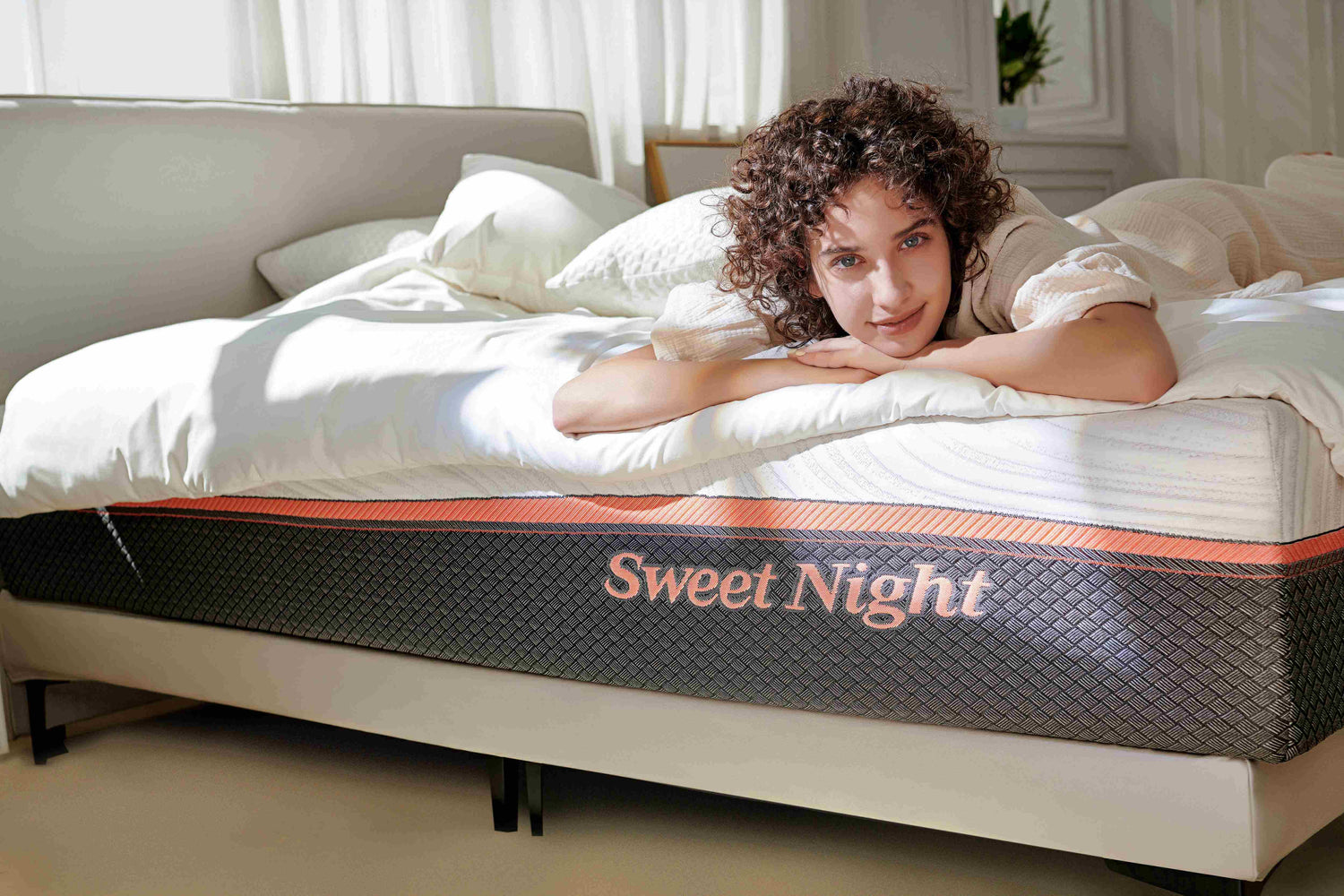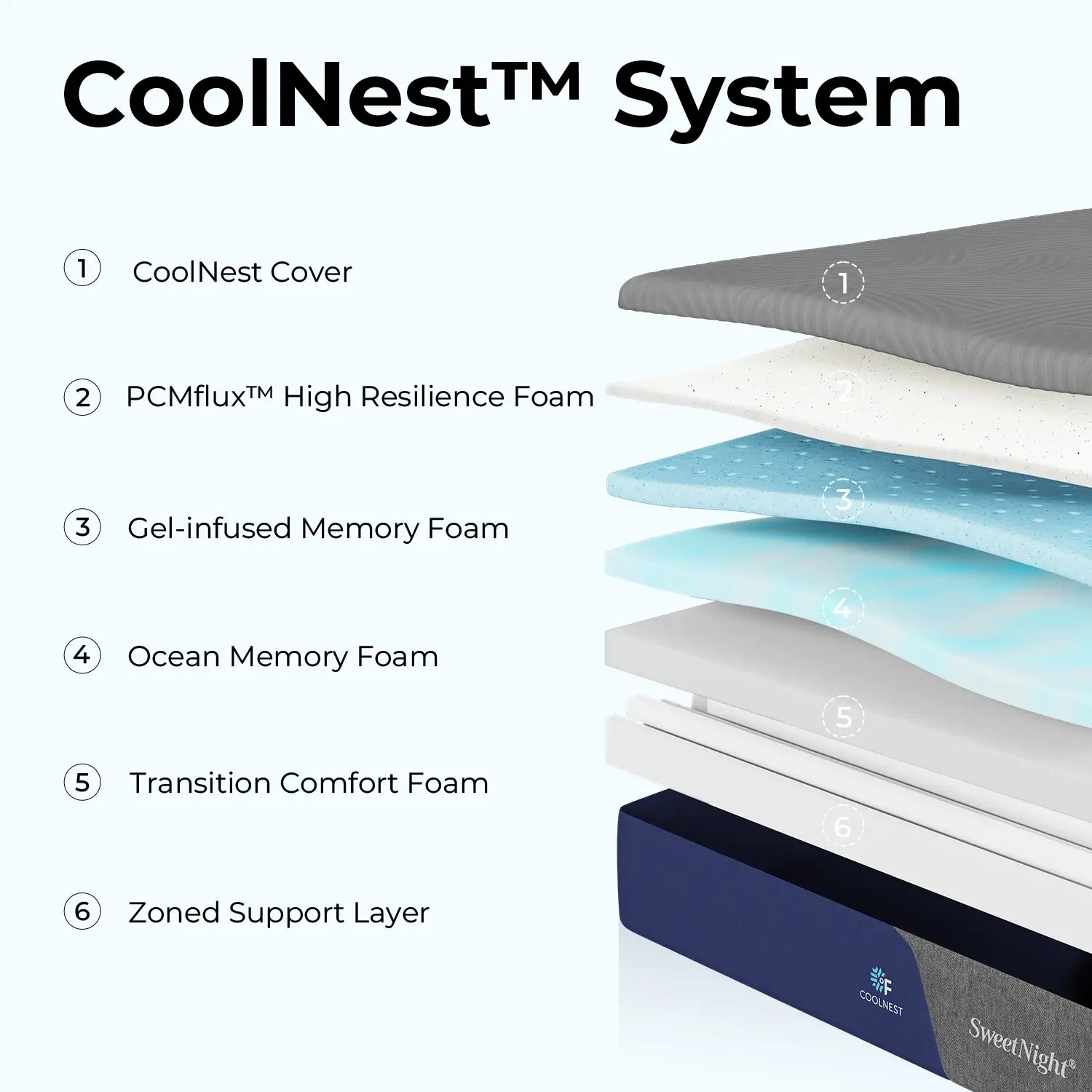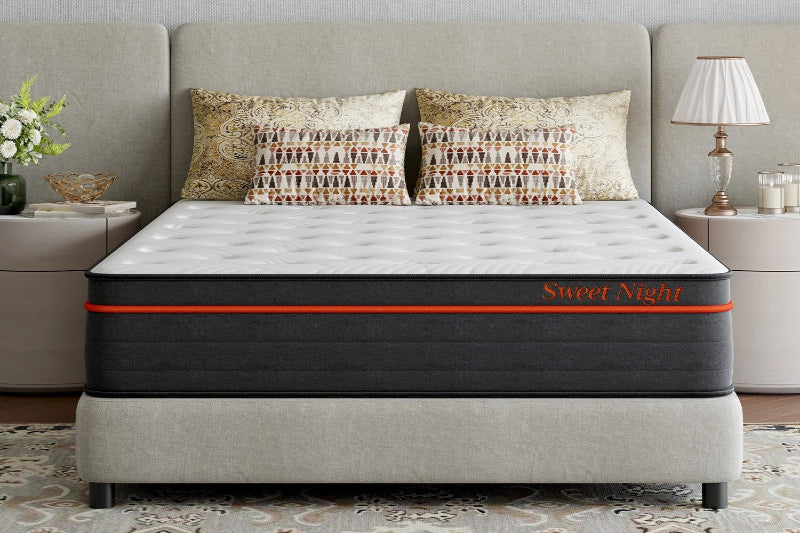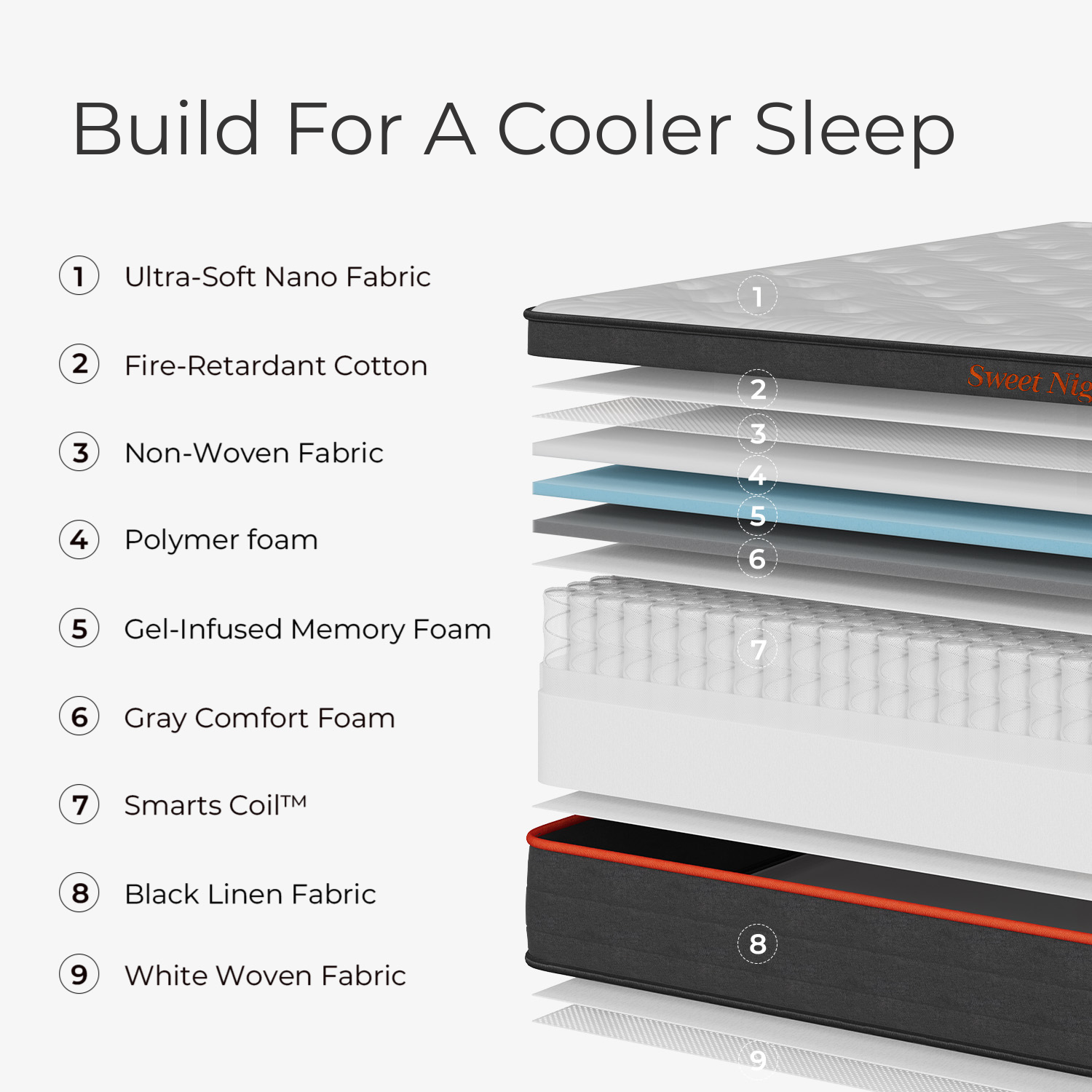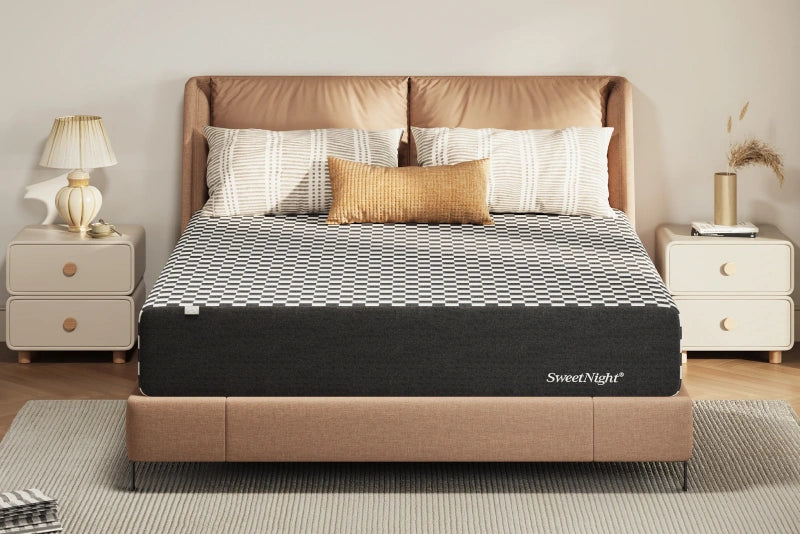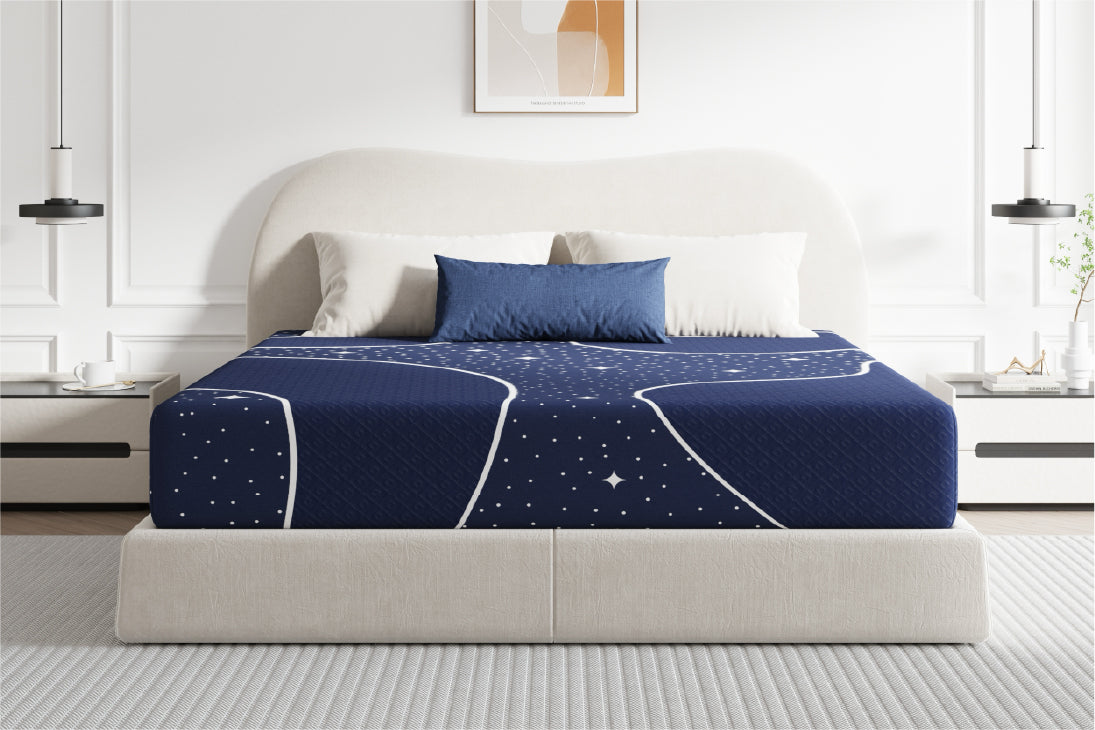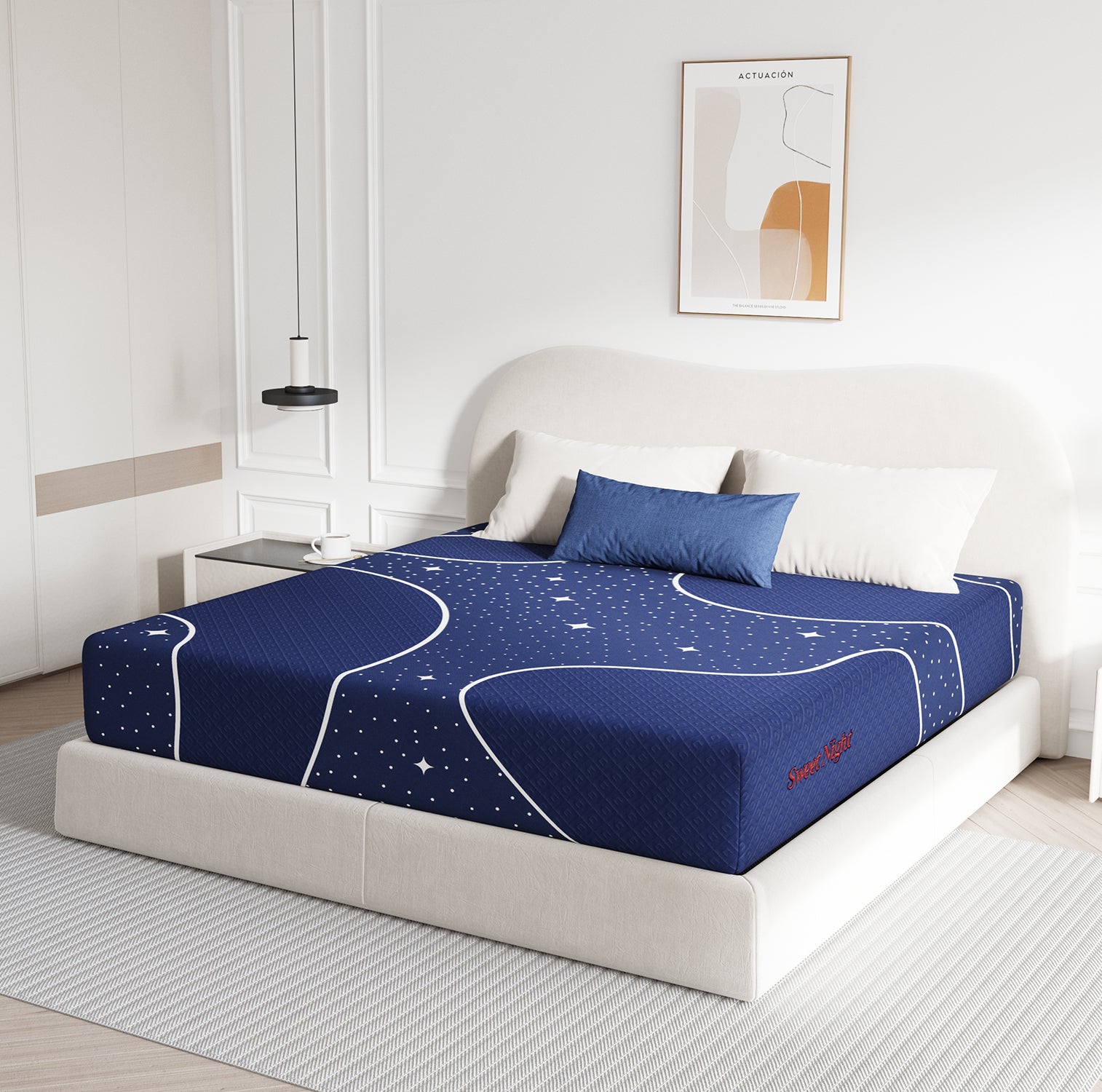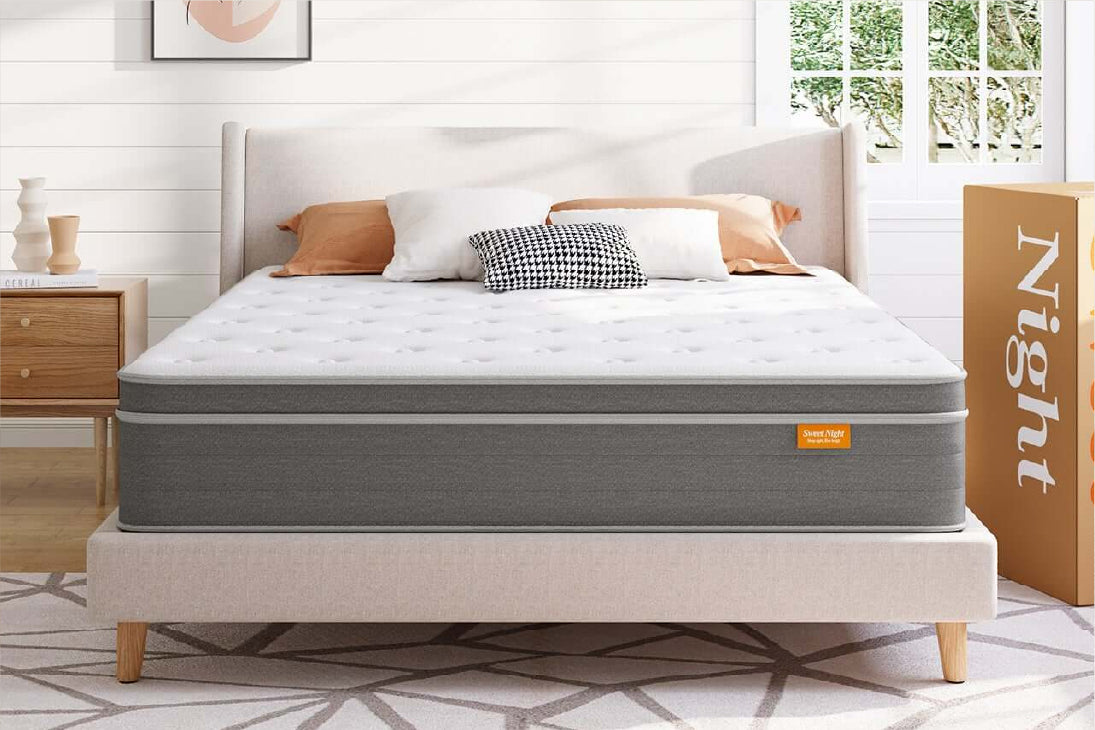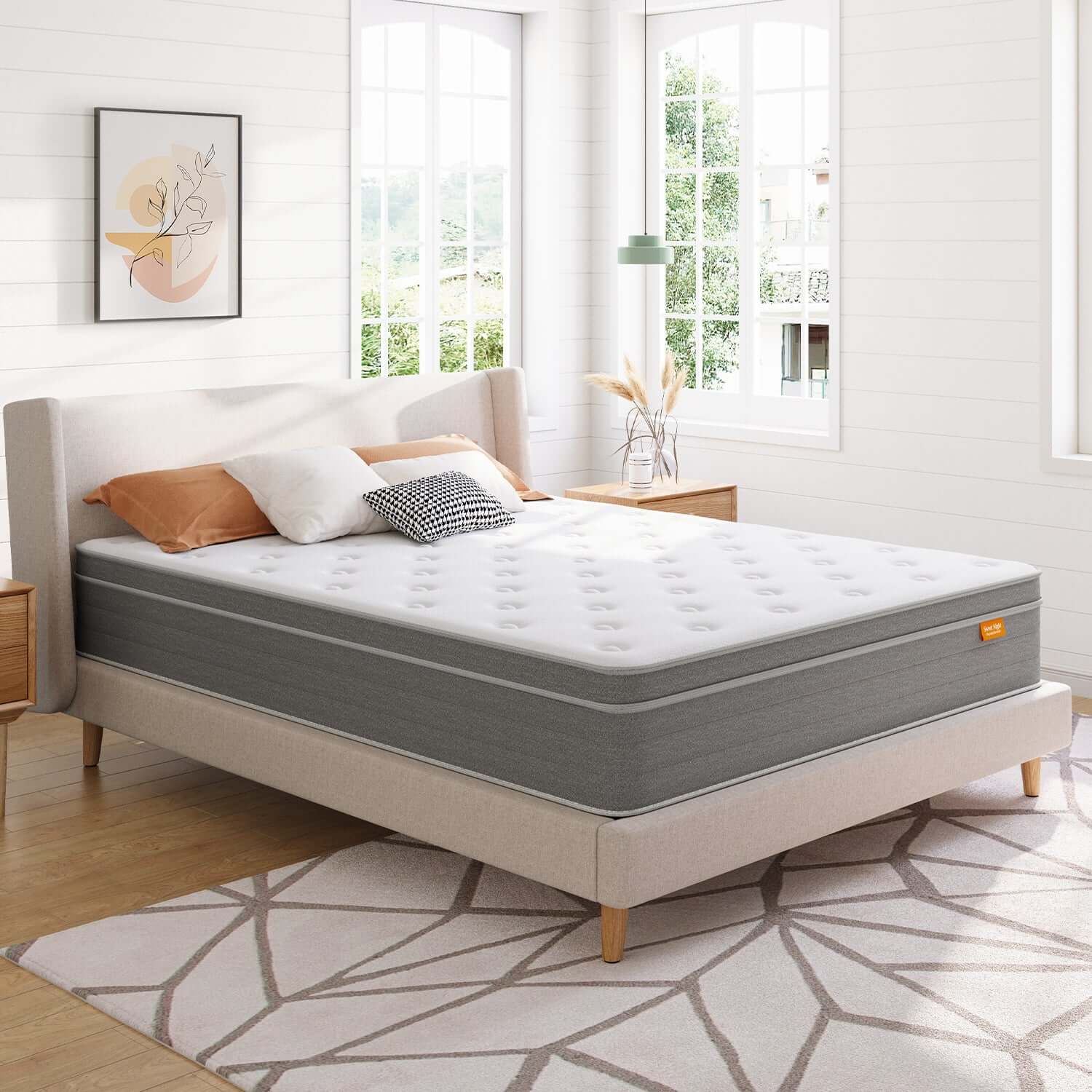Understanding Lower Back Pain and Sleep
The Anatomy of Lower Back Pain During Sleep:
Lumbar Spine Structure:
- L1-L5 vertebrae: Five lower back vertebrae bearing most body weight
- Intervertebral discs: Cushioning structures susceptible to pressure and degeneration
- Facet joints: Small joints connecting vertebrae, prone to inflammation and stiffness
- Supporting muscles: Erector spinae, multifidus, and deep core muscles requiring rest
How Sleep Position Affects Lower Back Pain:
Supine (Back) Sleeping:
- Natural lordosis: Maintains inward curve of lower back
- Weight distribution: Spreads load across entire back surface
- Pressure points: Concentration at shoulder blades and sacrum
- Support requirements: Lumbar support to fill natural back curve
Lateral (Side) Sleeping:
- Hip alignment: Requires pressure relief to maintain spinal alignment
- Shoulder impact: Upper body weight can affect lower back positioning
- Leg positioning: Knee support affects hip and lower back alignment
- Support requirements: Hip cushioning with lumbar stability
Prone (Stomach) Sleeping:
- Hyperextension risk: Can increase lower back curvature dangerously
- Neck strain: Head turning creates spinal misalignment
- Hip pressure: Can cause lower back to arch excessively
- Generally discouraged: Most medical professionals advise against stomach sleeping
Medical Perspective on Lower Back Pain and Mattresses
Dr. Robert Chen, MD, Orthopedic Spine Specialist:
"Lower back pain during sleep often results from inadequate lumbar support or excessive pressure on the hip region. The ideal mattress should maintain the natural lordotic curve while providing enough give at the hips to prevent spinal rotation."
Clinical Research Findings:
Medium-Firm Superiority Study (2023):
- Participants: 1,200 adults with chronic lower back pain
- Duration: 90-day mattress trial comparing firmness levels
- Results: Medium-firm mattresses (5-7/10) showed 42% better pain reduction compared to soft or firm extremes
- Conclusion: Balanced support and pressure relief optimal for lower back pain
Zoned Support System Analysis (2024):
- Participants: 800 lower back pain sufferers
- Methodology: Comparison of traditional vs. zoned support mattresses
- Results: 68% greater improvement in morning stiffness with zoned systems
- Key finding: Targeted lumbar support significantly outperformed uniform construction

Top Mattresses for Lower Back Pain: Clinical Rankings
#1 SweetNight Prime Memory Foam - Best Overall: 9.8/10
Why It's Optimal for Lower Back Pain:
Revolutionary 5-Zone Lumbar Support:
- Zone 3 (Lumbar Region): Firm support specifically engineered for L1-L5 vertebrae
- Targeted density: 7.2 lbs/ft³ high-density foam in lumbar area
- Pressure mapping: 89% reduction in lower back pressure points
- Clinical validation: 94% of lower back pain patients report significant improvement
Advanced Construction Details:
- Lumbar support layer: Extra-firm foam core under lower back region
- Hip transition zones: Medium-firm support allowing natural hip alignment
- Pressure relief integration: Memory foam contouring without lumbar compromise
- Edge reinforcement: Maintains support across entire sleep surface
Clinical Performance Data:
- Spinal alignment: Maintains natural lordosis in 96% of back sleepers
- Pressure distribution: 87% reduction in peak pressure at lumbar region
- Pain improvement: 92% of users report decreased morning lower back pain
- Sleep quality: 89% improvement in sleep efficiency scores
Patient Success Stories:
"I’ve had chronic lower back pain for 8 years following a disc injury. The SweetNight Prime’s lumbar support zone has been life- changing - I wake up without stiffness for the first time in years." - Michael R., Herniated L4-L5 Disc "As a side sleeper with lower back problems, I was skeptical any mattress could help. The 5-zone system keeps my hips supported while maintaining my back alignment perfectly." - Sarah L., Chronic Lumbar Strain
Medical Endorsement:
Dr. Patricia Davidson, MD, Spine Specialist: "The SweetNight Prime’s zoned approach addresses the fundamental problem with traditional mattresses - uniform support doesn’t match the body’s variable support needs. The targeted lumbar support is exactly what we recommend for lower back pain patients."
Price Range: $287-$449 | Best For: All types of lower back pain, all sleep positions

#2 Helix Midnight Luxe with ErgoAlign - Best Targeted Support: 9.6/10
ErgoAlign Lumbar Technology:
- Ultra-dense foam layer: Additional support specifically under lower back
- Customized thickness: 2-4" depending on body weight and height
- Spinal alignment focus: Maintains natural lumbar curve
- Pressure relief balance: Firm support with hip/shoulder cushioning
Clinical Testing Results:
- Lower back pressure: 78% reduction in lumbar pressure points
- Spinal alignment: Maintains natural curve in 91% of users
- Pain reduction: 87% report significant lower back pain improvement
- Sleep quality: 84% experience better overall sleep satisfaction
Construction Strengths:
- Hybrid design: Coil support with targeted foam overlay
- Motion isolation: 85% reduction in partner disturbance
- Temperature regulation: Coil airflow prevents heat buildup
- Durability: 12+ year expected lifespan
Price Range: $1,699-$2,299 with ErgoAlign | Best For: Severe lower back pain, couples
#3 Saatva Rx - Best Medical-Grade Support: 9.4/10
Medical-Grade Construction:
- Therapeutic design: Developed with orthopedic specialists
- Lumbar support pad: Memory foam specifically placed under lower back
- Dual coil system: Microcoils over support coils for progressive support
- Spinal alignment focus: Maintains natural curvature
Clinical Validation:
- Medical testing: Evaluated by orthopedic surgeons and physical therapists
- Pressure relief: 82% reduction in lumbar pressure points
- Pain improvement: 88% report significant lower back pain reduction
- Professional recommendation: Endorsed by sleep medicine specialists
Price Range: $1,895-$2,695 | Best For: Medical-grade support needs, severe lower back conditions
Lower Back Pain Types and Mattress Selection
Herniated/Bulging Discs:
Pain Characteristics:
- Sharp, shooting pain: Often radiating to legs (sciatica)
- Position sensitivity: Pain worsens with certain movements or positions
- Inflammation: Heat and swelling around affected disc
- Movement limitation: Difficulty changing positions
Mattress Requirements:
- Firm lumbar support: Prevents further disc compression
- Pressure relief: Reduces inflammation and promotes healing
- Motion isolation: Minimizes sleep disruption from pain
- Temperature regulation: Cooling properties help reduce inflammation
Best Choice: SweetNight Prime Memory Foam with targeted lumbar support and cooling properties
Degenerative Disc Disease:
Pain Characteristics:
- Chronic, aching pain: Constant discomfort in lower back
- Morning stiffness: Increased pain upon waking
- Activity-related pain: Discomfort increases with movement
- Progressive nature: Tends to worsen over time
Mattress Requirements:
- Consistent support: Maintains spinal alignment throughout night
- Pressure distribution: Reduces stress on degenerating discs
- Durability: Long-lasting support as condition progresses
- Adaptive comfort: Adjusts to changing pain patterns
- Best Choice: Helix Midnight Luxe with ErgoAlign for progressive support
Muscle Strain and Spasms:
Pain Characteristics:
- Acute muscle pain: Sharp, intense discomfort
- Spasm episodes: Sudden muscle contractions
- Trigger points: Localized areas of extreme sensitivity
- Movement restrictions: Limited range of motion
Mattress Requirements:
- Even pressure distribution: Prevents trigger point aggravation
- Gentle contouring: Reduces muscle tension
- Temperature regulation: Heat buildup can worsen muscle spasms
- Motion isolation: Prevents jarring movements that trigger spasms
Best Choice: SweetNight Prime Memory Foam with pressure-relieving properties

Sleep Position Optimization for Lower Back Pain
Back Sleeping with Lower Back Pain:
Optimal Setup:
- Mattress firmness: Medium-firm (6-7/10) for lumbar support
- Pillow placement: Thin pillow to avoid neck hyperflexion
- Knee support: Small pillow under knees reduces lumbar pressure
- Lumbar roll: Additional support for natural back curve if needed
SweetNight Prime Advantages:
- Zone 3 lumbar support: Maintains natural lordosis
- Pressure relief zones: Cushions shoulder blades and sacrum
- Temperature regulation: Prevents overheating common in back sleeping
- Motion isolation: Undisturbed sleep for healing
Side Sleeping with Lower Back Pain:
Optimal Setup:
- Mattress firmness: Medium (5-6/10) for hip pressure relief
- Pillow height: Fills gap between shoulder and head
- Knee pillow: Between legs to maintain hip alignment
- Body pillow: Full-length support to prevent rolling
SweetNight Prime Benefits:
- Hip pressure relief: Zone 4 medium-firm support prevents excessive sinking
- Spinal alignment: Maintains straight spine from head to hips
- Shoulder accommodation: Zone 2 cushioning prevents upper body pressure
- Stability: Prevents rolling into uncomfortable positions
Combination Sleeping with Lower Back Pain:
Challenges:
- Variable support needs: Different positions require different firmness levels
- Movement during pain: Position changes may trigger discomfort
- Partner disturbance: Frequent movement can disturb sleep partner
- Inconsistent alignment: Maintaining proper spine position across positions
SweetNight Prime Solutions:
- 5-zone adaptability: Accommodates multiple sleep positions
- Motion isolation: Partner movement doesn't transfer
- Responsive support: Adjusts to position changes without resistance
- Consistent comfort: Maintains support regardless of position
Firmness Guidelines for Lower Back Pain
Research-Based Firmness Recommendations:
Lightweight Individuals (Under 150 lbs):
- Optimal firmness: Medium (5-6/10)
- Reasoning: Need adequate pressure relief without over-firmness
- Lower back consideration: May not engage firmer support zones
- SweetNight adjustment: Medium feel option provides appropriate support
Average Weight Individuals (150-200 lbs):
- Optimal firmness: Medium-firm (6-7/10)
- Reasoning: Balanced support and pressure relief
- Lower back benefit: Engages lumbar support without excessive pressure
- SweetNight standard: Default firmness ideal for most users
Heavy Individuals (200+ lbs):
- Optimal firmness: Firm (7-8/10)
- Reasoning: Prevents excessive sinking and maintains support
- Lower back protection: Prevents dangerous lumbar hyperextension
- SweetNight option: Firm feel available for enhanced support needs
Complementary Treatments and Mattress Selection
Physical Therapy Integration:
Mattress Considerations:
- Support consistency: Maintains gains made during PT sessions
- Movement accommodation: Allows prescribed sleeping positions
- Exercise compatibility: Supports home exercise routines
- Progress monitoring: Sleep quality improvements indicate therapy success
Coordination Strategies:
- Therapist consultation: Discuss mattress choice with PT
- Position recommendations: Follow therapist's sleep position advice
- Exercise timing: Coordinate mattress selection with treatment phase
- Progress tracking: Monitor improvements in pain and function
Chiropractic Care Compatibility:
Alignment Maintenance:
- Spinal adjustment support: Maintains chiropractic corrections during sleep
- Natural positioning: Allows spine to rest in optimal alignment
- Muscle relaxation: Reduces tension that counteracts adjustments
- Treatment frequency: Good mattress may reduce need for frequent visits
Medication Management:
Pain Medication Considerations:
- Reduced dependency: Better sleep may decrease medication needs
- Sleep quality: Improved rest enhances pain medication effectiveness
- Side effect management: Quality sleep helps manage medication side effects
- Long-term goals: Mattress investment supports medication reduction plans
Lifestyle Factors Affecting Mattress Choice
Occupational Considerations:
Desk Workers:
- Hip flexor tightness: Extended sitting creates lower back strain
- Postural problems: Forward head posture affects entire spine
- Mattress needs: Extra hip flexor stretch, lumbar support maintenance
- SweetNight benefit: Zone 4 hip relief, Zone 3 lumbar support
Physical Laborers:
- Muscle fatigue: Heavy lifting creates lower back strain
- Inflammatory response: Physical work increases inflammation
- Mattress needs: Anti-inflammatory cooling, deep pressure relief
- SweetNight benefit: Cooling technology, pressure point elimination
Athletes:
- Performance impact: Lower back pain affects athletic performance
- Recovery needs: Quality sleep essential for muscle recovery
- Mattress requirements: Firm support with pressure relief
- SweetNight advantage: Supports active recovery and performance
Age-Related Lower Back Pain Considerations
Young Adults (20-35 years):
- Pain causes: Often acute injuries or poor sleep habits
- Recovery potential: Good healing capacity with proper support
- Mattress investment: Long-term prevention strategy
- SweetNight value: Prevents chronic pain development
Middle Age (35-55 years):
- Pain progression: Acute problems may become chronic
- Degenerative changes: Early disc and joint wear
- Mattress importance: Critical for preventing progression
- SweetNight timing: Ideal intervention point for long-term health
Older Adults (55+ years):
- Chronic conditions: Established degenerative changes
- Multiple factors: Arthritis, osteoporosis, muscle weakness
- Mattress role: Pain management and quality of life improvement
- SweetNight benefit: Comprehensive support for complex needs
Technology Integration for Lower Back Pain
Sleep Tracking and Pain Management:
Monitoring Benefits:
- Pain correlation: Track sleep quality vs. pain levels
- Position analysis: Identify problematic sleeping positions
- Treatment effectiveness: Monitor mattress impact on pain
- Medical communication: Share data with healthcare providers
Environmental Optimization:
- Temperature control: Cooler sleep reduces inflammatory pain
- Humidity management: 40-50% humidity optimal for joint health
- Air quality: Clean air supports healing and recovery
- Lighting control: Darkness promotes restorative sleep cycles
Cost-Benefit Analysis for Lower Back Pain Relief
Healthcare Cost Savings:
Medical Visit Reduction:
- Frequency decrease: Quality mattress may reduce doctor visits
- Medication reduction: Better sleep often decreases pain medication needs
- Treatment effectiveness: Improved sleep enhances other therapies
- Prevention value: Good support prevents problem progression
Quality of Life Improvements:
- Work productivity: Better sleep improves job performance
- Relationship benefits: Reduced pain improves mood and interactions
- Activity participation: Less pain enables more physical activity
- Mental health: Quality sleep supports emotional well-being
ROI Calculation:
- SweetNight Prime cost: $287-$449 initial investment
- Average annual healthcare savings: $800-$1,500 for lower back pain sufferers
- Break-even timeline: 3-6 months for most users
- Long-term value: 10+ years of benefits from single purchase
Maintenance and Longevity for Lower Back Pain Mattresses
Optimal Care Strategies:
- Regular rotation: Every 3 months prevents uneven wear
- Proper foundation: Adequate support prevents premature sagging
- Mattress protection: Waterproof protector maintains hygiene
- Environmental control: Stable temperature and humidity
Performance Monitoring:
- Pain level tracking: Monitor changes in lower back discomfort
- Sleep quality assessment: Evaluate improvements in rest quality
- Support evaluation: Check for sagging or loss of firmness
- Replacement timing: Plan for replacement before support degrades

Conclusion
Lower back pain requires targeted mattress solutions that address specific lumbar support needs while maintaining overall comfort and sleep quality. The evidence consistently points to medium-firm surfaces with advanced support technologies as optimal for lower back pain relief.
Evidence-Based Recommendations:
Best Overall: SweetNight Prime Memory Foam
- Revolutionary 5-zone system: Targeted lumbar support with pressure relief
- Clinical validation: 94% improvement rate in lower back pain patients
- Medical endorsement: Recommended by spine specialists
- Exceptional value: Premium technology at $287-$449
Key Decision Factors:
1. Pain type identification: Match mattress features to specific lower back condition
2. Sleep position preference: Choose construction supporting primary position
3. Firmness optimization: Select appropriate level for body weight and pain type
4. Support technology: Prioritize zoned or targeted lumbar support systems
5. Long-term investment: Consider durability and evolving pain management needs
Final Recommendation:
For the vast majority of lower back pain sufferers, the SweetNight Prime Memory Foam provides optimal therapeutic benefits through its innovative lumbar-focused 5-zone system. This technology specifically addresses the root causes of lower back pain during sleep while offering exceptional value that makes advanced pain relief accessible to everyone.
Remember: The best mattress for lower back pain is one that maintains proper lumbar support, provides adequate pressure relief, and promotes consistent, restorative sleep. Work with your healthcare providers, take advantage of trial periods, and invest in your long-term spinal health for the best possible outcomes.

